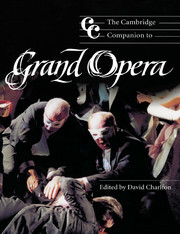Book contents
- Frontmatter
- 1 Introduction
- Part I The resourcing of grand opera
- 2 The ‘machine’ and the state
- 3 Fictions and librettos
- 4 The spectacle of the past in grand opera
- 5 The chorus
- 6 Dance and dancers
- 7 Roles, reputations, shadows: singers at the Opéra, 1828–1849
- Part II Revaluation and the twenty-first century
- Part III Grand operas for Paris
- Part IV Transformations of grand opera
- Notes
- Select bibliography
- Index
7 - Roles, reputations, shadows: singers at the Opéra, 1828–1849
from Part I - The resourcing of grand opera
Published online by Cambridge University Press: 28 November 2011
- Frontmatter
- 1 Introduction
- Part I The resourcing of grand opera
- 2 The ‘machine’ and the state
- 3 Fictions and librettos
- 4 The spectacle of the past in grand opera
- 5 The chorus
- 6 Dance and dancers
- 7 Roles, reputations, shadows: singers at the Opéra, 1828–1849
- Part II Revaluation and the twenty-first century
- Part III Grand operas for Paris
- Part IV Transformations of grand opera
- Notes
- Select bibliography
- Index
Summary
‘The devil who steals Peter Schlemihl's shadow’
In an 1841 puff piece on the soprano sensation of the moment, Sofia Loewe, Henri Blaze de Bury related that Giacomo Meyerbeer had recently become so infatuated with Loewe's voice that he had gone religiously to hear her sing in Berlin, hiding himself behind the curtains of a loge and noting down details of her technique, hoping to cast her in his next opera. Blaze de Bury concluded:
Meyerbeer is made so: he travels around the world in search of beautiful voices; as soon as he encounters one he copies it into a notebook, and thus he constructs in his imagination a dream cast for his next opera … Do you not find that there is something fantastic in this manner of collecting sopranos, tenors, and basses? Meyerbeer cuts out a beautiful voice for us, no more or less than that devil who steals Peter Schlemihl's shadow on a moonlit night, folds it up and hides it away in his wallet.
The vaguely sinister image of the composer scribbling furiously in the obscure depths of his opera box is given an extra uncanny tinge by the allusion to Peter Schlemihl, a folk character immortalised in an 1814 novella by Adalbert Chamisso, who sells his shadow (in reality, his soul) to the devil in exchange for limitless wealth.
- Type
- Chapter
- Information
- The Cambridge Companion to Grand Opera , pp. 108 - 128Publisher: Cambridge University PressPrint publication year: 2003
- 1
- Cited by

